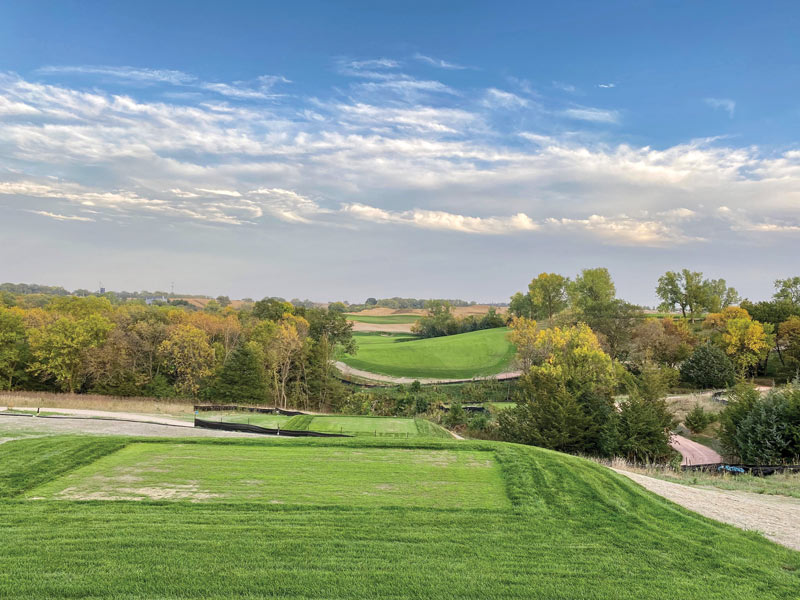
The 17th hole at Lost Rail Golf Club just outside of Omaha, Neb., which is scheduled to open for play later this year. Photos courtesy of Landscapes Unlimited
Babe Ruth did it in New York with the 1923 opening of the original Yankee Stadium. More than 70 years later, Deion Sanders claimed he did the same for the Georgia Dome during his time playing with the Atlanta Falcons.
Now, much like the nicknames bestowed upon the cathedrals these two sports superstars figuratively built for their respective teams, Lost Rail Golf Club has earned an unofficial moniker that acknowledges the entity that, to some degree, helped give it
rise.
“We call it the course that COVID built,” says Jim Flynn, president of Landscapes Development Co., the company behind the development of this soon-to-open private facility located on the outskirts of Omaha, Neb. “The demand for golf
got so crazy (during the pandemic) that we sort of took a leap of faith.”
Technically, Lost Rail is the course that Scott Hoffman built — with the support and backing of Landscapes Unlimited through its development arm Landscapes Development Co. and with the operational leadership of its sister company, Landscapes Golf Management.
And that leap of faith? Trusting that a sufficient number of golf enthusiasts in and around Omaha loved the game enough that they’d spend their hard-earned dollars to join a course that was barely more than an idea — all while they and the
rest of the world stood still.
Selling a dream
Hoffman had always dreamed of building a golf course in his native Omaha. The former associate with Fazio Design was well aware of golf’s rich history in Nebraska and felt that local purists were longing for a top-tier design, which he was eager
to deliver.
Before he could turn his dream into a reality, however, Hoffman needed a partner who shared his belief that a golf-only club would work in this part of the world.
It wouldn’t be easy. More than two decades had passed since the last private course had come on line in the area, and suitable land was scarce.
Eventually, Hoffman located a site where he could build his course. Then, he found a kindred spirit in Bill Kubly, owner and CEO of Lincoln-based Landscapes Unlimited.
Kubly also hails from the Omaha area, and Hoffman worked for him in the late 1990s after graduating from Creighton University. So there was a connection, an appreciation for the region and a familiarity with how each one approached projects. More importantly,
Kubly believed in Hoffman’s vision that Omaha could support a private club on par with other Nebraska golf bastions like Sand Hills, Dismal River and The Prairie Club.
The two joined forces and set their plan in motion. By late 2019, Landscapes was deep into negotiations for the property in western Omaha that Hoffman had pinpointed. Then, things stalled. The deal ultimately fell apart, seemingly slamming the doors on
the club before they even opened.
Determined to find another site to bring his brainchild to life, Hoffman and his cousin, Dirk Chatelain, a sports reporter for the Omaha World-Herald, started scouting land along the abandoned railbed that cut through town. That’s when
they discovered a 155-acre piece of property overlooking the Elkhorn River. It boasted 20-mile views, 40-foot ravines and what was left of a Burlington Northern railroad line that once connected Omaha to Sioux City, Iowa.
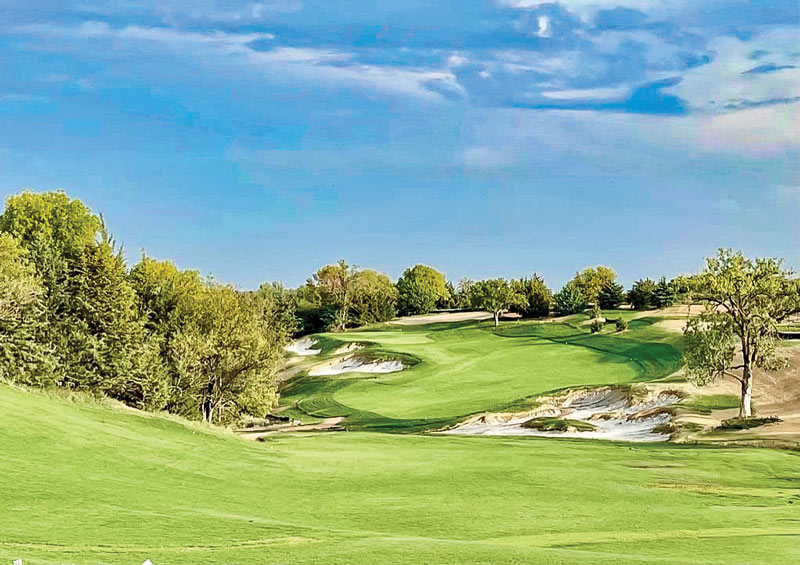
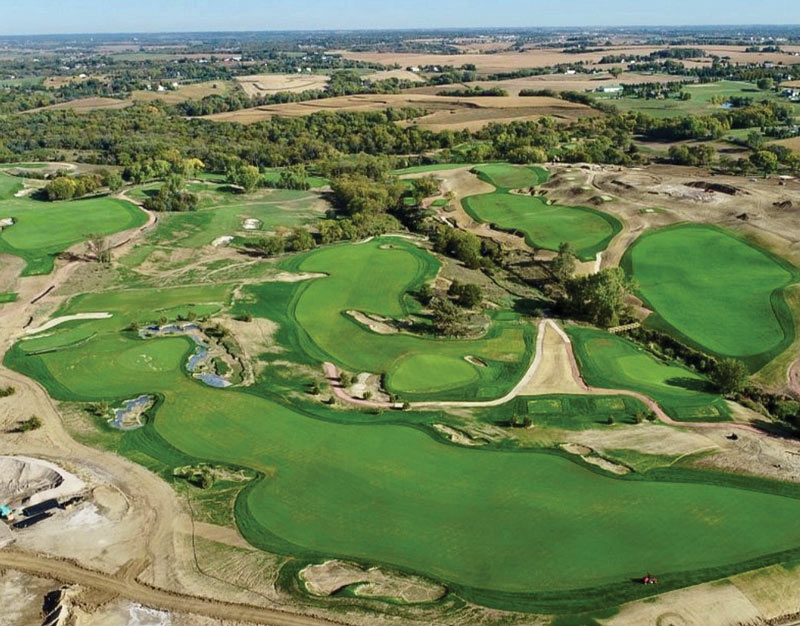
A motivated team that included golf course architect Scott Hoffman and Bill Kubly with Landscapes Unlimited identified a 155-acre
tract of land northwest of Omaha, Neb., as the perfect site for Lost Rail Golf Club. Shown here are the second hole (top) and an aerial shot of the property.
The only problem was the land wasn’t for sale. Marleen Muenster, a retired schoolteacher in her early 70s, owned the property and had been fending off developers for 20 years since her husband passed away.
Undaunted, Hoffman and his cousin cold-called Muenster, who, Hoffman said, “immediately treated us like old friends.” She listened to the proposal for a pure golf club devoid of housing and all the other trappings of a country club. Then and
there, Muenster agreed to sell.
“She wasn’t a golfer by any means,” Flynn says, “but she liked the idea of her property not ‘going to concrete,’ as she described it. I don’t know if it was fate, but the fact that it worked out the way it did
is pretty special.”
By December 2019, Landscapes was finalizing details to purchase Muenster’s property and lining up investors. Hoffman, for his part, had mapped out the course and was ready to press forward. The excitement was palpable, and momentum was swelling.
Then, roughly three months later, life as everyone knew it ground to a halt. The team hit pause on Lost Rail, unsure what the future held as the pandemic turned the world on its head.
Taking the leap
While the rest of the nation convulsed, Muenster remained resolute in her commitment to Lost Rail. She extended the six-month option on the property, virtually willing the project forward even as she struggled with her own declining health.
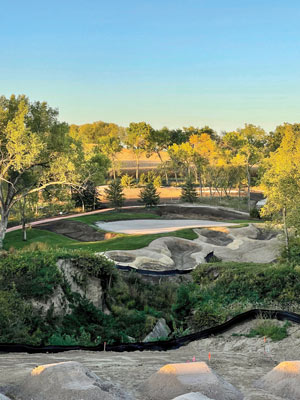
Right: The fifth hole at Lost Rail Golf Club.
As months dragged on, golf courses in Omaha, much like others across the United States, began experiencing a surge in play from avid, casual and new golfers alike. Tee sheets filled, and courses were teeming with people searching for a respite from the
monotony of life in lockdown. It was a blessing for the golf industry, but a curse for core players who weren’t accustomed to competing with others for tee times.
The development team took note and decided to test the area’s appetite for Lost Rail. Rather than asking potential members to pony up tens of thousands of dollars to join a club that hadn’t even broken ground yet, Lost Rail asked for a $1,000
refundable deposit from each person interested in joining. If the demand were there, great; if not, both parties had an easy out.
“By the Fourth of July (2020), we had 75 people signed up, so the proof of concept was there,” Flynn says. “That made going to partners and asking for money pretty easy. From there, it just snowballed with a grassroots campaign.”
In fact, most marketing for Lost Rail was and always has been word of mouth, coupled with some social advertising and organic posts on Twitter and Instagram. The response surprised everyone, even those who’d been in the business for decades and
witnessed the rapid growth in course building during the early 2000s.
“It was all just people calling,” Flynn notes. “It wasn’t selling anything; it was just taking orders. I’ve never seen interest like this in a golf project. Ever.”
Proximity to two metropolitan areas — Lincoln and Omaha — certainly didn’t hurt. Nor did the fact that Omaha is home to several Fortune 500 companies, including Berkshire Hathaway, Union Pacific, Mutual of Omaha and TD Ameritrade.
“Since it’s so close to Omaha and Lincoln, prospective members could actually come out here and ‘kick the tires’ by walking the site,” Flynn says. “That was a pretty important element, because everyone who came out
here could stand on the future site of the clubhouse and see where the 16th and 18th holes were going to be.
“It was things like that and having a place where they can get away from it all but still be just 20 minutes from home,” adds Flynn, who likens the convergence of latent demand for tee times and a dwindling supply of them in Omaha to a “perfect
storm” for launching a project like Lost Rail.
Executing a plan
In many ways, the evolution of Lost Rail has mirrored the “build it and they will come” philosophy popularized in the 1989 semifictional homage to baseball, “Field of Dreams.”
Hoffman, like the movie’s protagonist, Ray Kinsella, developed a blueprint for a course that no one else had taken the time to envision. Jack Morgan, in some respects, played the role of Terence Mann at Lost Rail, one of the few who could see what
Hoffman saw in the land and was in a position to help bring that vision to fruition.
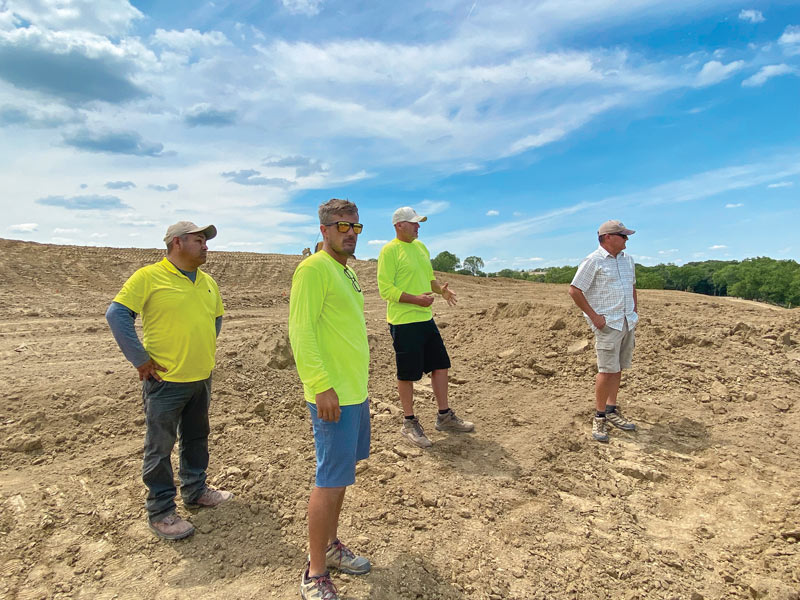
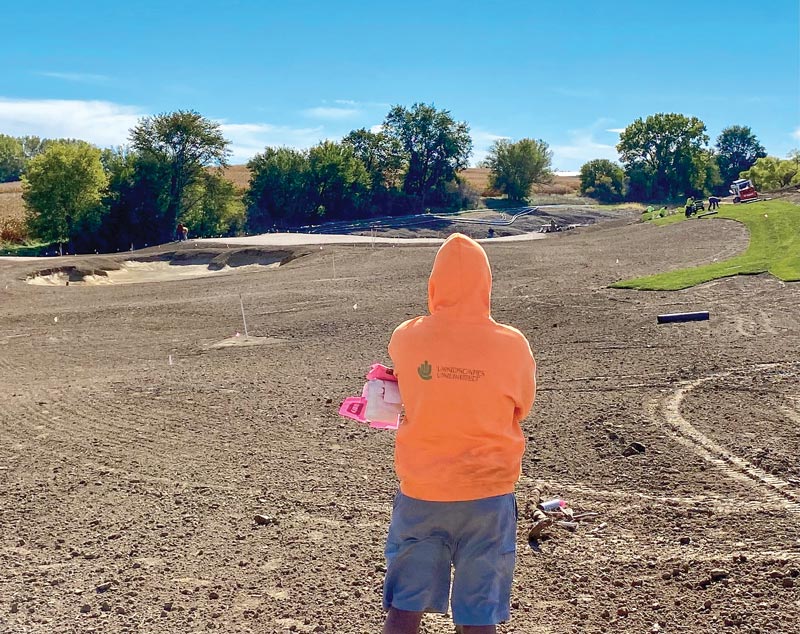

Those involved in the development and construction of Lost Rail Golf Club — including GCSAA Class A superintendent Ahren Wonderlich — often refer to it as the “course that COVID built,” as much of the work on the property took place during the heart of the pandemic.
Morgan is the vice president of the Project Development Group of Landscapes Unlimited, a 30-plus-year industry veteran who has led turnkey project management efforts at dozens of public and private facilities across the United States and internationally.
Once Lost Rail was greenlighted in November 2020, his mission was to assemble and supervise the team that would execute Hoffman’s plan.
One of the first individuals Morgan reached out to was one of his own — Ahren Wonderlich, the GCSAA Class A superintendent of The Players Club in Omaha at the time — to gauge his interest in being the grow-in superintendent at Lost Rail and
later take over full-time maintenance duties. Landscapes Unlimited served as the construction partner for the Arnold Palmer-designed Players Club at Deer Creek in the late 1990s. Landscapes Golf Management, a management services team and sister company to Landscapes Unlimited, took over management and has operated the 27-hole facility since its opening day in 2000.
Initially, Wonderlich was hesitant. He’d been with Landscapes Golf Management since the early 2000s, the last 10 years of which were at Players Club. Things were going well, and he wasn’t really looking to make a move.
“But the more I thought about it and talked to my wife about it, I would’ve been a fool not to do it,” says Wonderlich, a 20-year GCSAA member. “These types of projects aren’t happening too often anymore, so that and being
able to stay in the Landscapes family without having to move (away from Omaha) made it very intriguing.”
What ultimately sold Wonderlich on Lost Rail was the plan to create a rural retreat within a 20-minute drive of a major metropolitan area. No housing development and curious neighbors to contend with — just pure golf at a private club with a limited
membership.
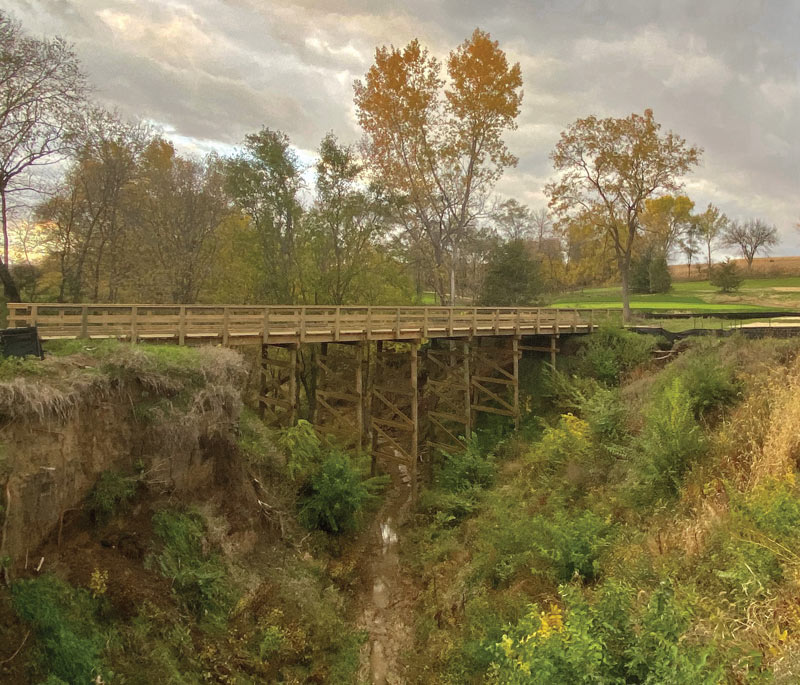
A bridge over a ravine connects the fifth and sixth holes at Lost Rail Golf Club. The property boasts 20-mile views, 40-foot ravines and what’s left of a Burlington Northern railroad line that once connected Omaha
to Sioux City, Iowa.
“I was at a 27-hole facility with about 700 homes on it, and now I’m back to 18 holes,” says Wonderlich, who now carries the title of director of agronomy at Lost Rail. “It’s very rare to find a golf course in this area that
doesn’t have homes on it. That was a big selling point for me.” So, too, was the opportunity to work with new turf varieties on a course that he calls “phenomenal” and “hard to put into words.”
Perhaps it’s the site’s natural topography that leaves Wonderlich at a loss for adjectives to describe the course. This, combined with Hoffman’s practice of letting the land dictate design, makes it difficult to pigeonhole Lost Rail
into a single classification. The routing traverses three distinct environments, twisting through wooded corridors that evoke a parkland feel before plunging into and out of ravines and meandering across rolling pastureland reminiscent of classic
links-style courses.
“From an aesthetic standpoint, it keeps changing, which makes the course very memorable,” Flynn says. “There’s a lot of elevation change and dramatic topography, but there’s nothing fake or fabricated out there.”
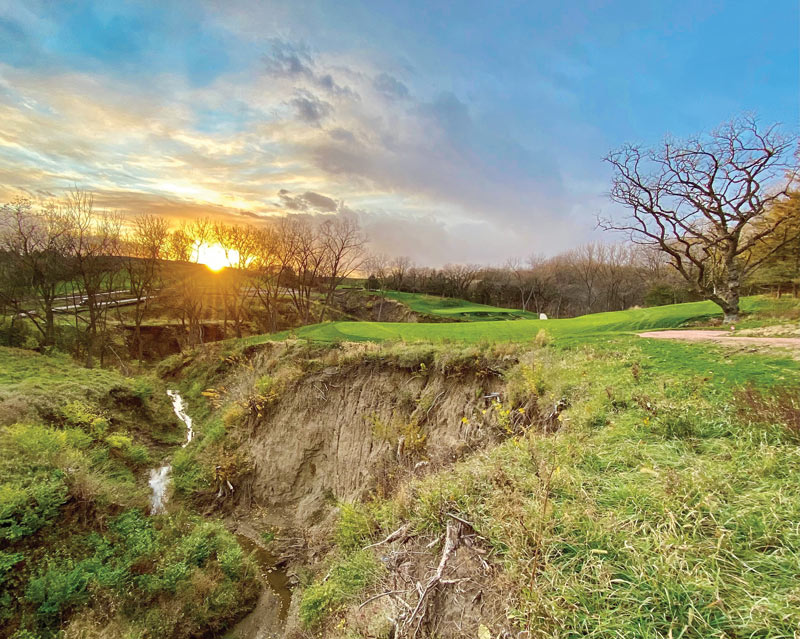
The ninth hole at Lost Rail Golf Club near Omaha, Neb. The design for the course used the area’s natural topography and features such as this ravine to guide its routing and layout.
For his part, Wonderlich appreciates the blend of old and new elements that Hoffman wove into the design. The architect incorporated greens ranging in size from 2,500 square feet to more than 12,000, as well as a mix of small and large bunkers and square
tee boxes. Fairways are wide, ranging from 50 to 70 yards, and rough is minimal.
“(The fairways are) probably the most unique thing that sets Lost Rail apart,” Wonderlich says. “As far as a superintendent’s point of view, I’m going to have a lot more grass to take care of than the ‘average’
18-hole superintendent in the Omaha area.”
Staying the course
Once he took the job, Wonderlich spent his first few months familiarizing himself with the Lost Rail property, collaborating with Hoffman on design tweaks and overseeing installation of the irrigation and drainage systems. He and members of the Landscapes
Unlimited team also grassed the majority of the course in late July 2021 and were mowing greens within 15 days.
By and large, development of Lost Rail has progressed smoothly, save for supply chain issues that have impacted every industry and periods of severe weather. In fact, Mother Nature posed the biggest obstacles during construction.
Violent thunderstorms plagued the Omaha region throughout August. The storms caused numerous delays and forced Wonderlich and the construction crew to rework washed-out areas multiple times. “It really hurt us and set us back,” he says. “But
we fought and clawed and got back on schedule.”
Later in the year, Mother Nature made amends for the damage she wrought just a few months earlier. The region enjoyed temperate weather in November and December, allowing Wonderlich to work up until roughly the Christmas break, something he says is “typically
unheard of in the Omaha area.”
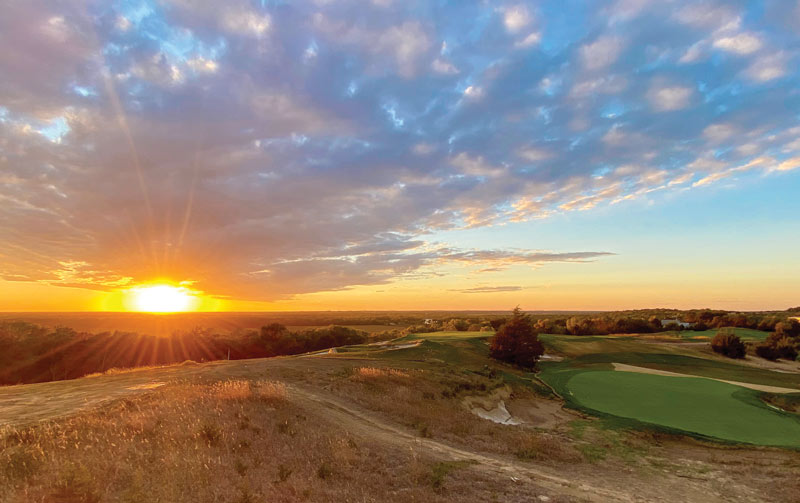
A sunrise over the 16th and 18th holes at Lost Rail Golf Club, which is expected to open for play in July of this year.
Now, as temperatures warm again and Lost Rail awakens from its seasonal slumber, the development team will focus on finishing bunker construction and reworking any areas that may have been damaged over the winter. Meanwhile, Wonderlich will be tending
to four holes that were struggling prior to the winter break and may need reseeding. He also has a few miscellaneous construction projects to complete before shifting his attention to hiring a maintenance staff.
Barring any major setbacks, Lost Rail remains on pace to open by July of this year. The club’s 200 local memberships sold out in January, leaving Lost Rail in the enviable position of having to put prospects on a waiting list.
One person who won’t be at the ribbon cutting is Muenster, who passed away in December 2020, roughly a year after Hoffman first visited her to pitch his dream. In many ways, the official opening of Lost Rail will fulfill her legacy while launching
a new phase in a journey that has been two years in the making and driven in large part by circumstances beyond anyone’s control.
“The dynamic shifts in our personal and professional lives brought about by COVID has kind of dictated what’s important to us,” Flynn says. “A lot of people want to stay close to home but still have a chance to get away, and purist
golfers want to weed out the distractions. They don’t want weddings or retirement parties or tennis. They just want to play golf over and over at a world-class golf course.”
Lost Rail seems destined to fulfill that mission, but only time will tell if it goes on to become as famous as The House that Ruth Built or the one that Sanders helped to inspire. What seems certain, however, is that the story of how one native son joined
forces with two other loyal Nebraskans to transform former farmland into a course of dreams will remain woven into the fabric of Omaha lore for generations to come.
Ronnie Musselwhite is a South Carolina-based freelance writer and former editor-in-chief of Golf Business, the publication of the National Golf Course Owners Association.